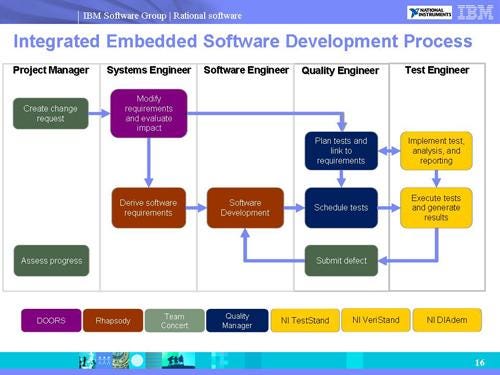IBM, NI Plug Systems Engineering Gap
June 27, 2012

With the number of lines of code in the average car expected to skyrocket from 10 million in 2010 to 100 million in 2030, there's no getting around the fact that embedded software development and a systems engineering approach has become central not only to automotive design, but to product design in general.
Yet despite the invigorated focus on what is essentially a long-standing design process, organizations still struggle with siloed systems and engineering processes that stand in the way of true systems engineering spanning mechanical, electrical, and software functions. In an attempt to address some of those hurdles, IBM and National Instruments are partnering to break down the silos specifically as they relate to the quality management engineering system workflow, or more colloquially, the marriage between design and test.

"As customers go through iterative development cycles, whether they're building a physical product or a software subsystem, and get to some level of prototype testing, they run into a brick wall around the manual handoff between the development and test side," Mark Lefebvre, director, systems alliances and integrations, for IBM Rational, told us. "Traditionally, these siloed processes never communicate and what happens is they find errors downstream in the software development process when it is more costly to fix."
NI and IBM's answer to this gap? The pair is building a bridge -- specifically an integration between IBM Rational Quality Manager test management and quality management tool, and NI's VeriStand and TestStand real-time testing and test-automation environment. The integration, Lefebvre said, is designed to plug the gap and provide full traceability of what's defined on the test floor back to design and development, enabling more iterative testing throughout the lifecycle and uncovering errors earlier in the process, well before building costly prototypes.
The ability to break down the quality management silos and facilitate earlier collaboration can have a huge impact on cost if you look at the numbers IBM Rational is touting. According to Lefebvre, a bug that costs $1 to fix on a programmer's desktop costs $100 to fix once it makes its way into a complete program and many thousands of dollars once identified after the software has been deployed in the field.
While the integration isn't yet commercialized (Lefebvre said to expect it at the end of the third quarter), there is a proof of concept being tested with five or six big NI/IBM customers. The proof of concept is focused on the development of an embedded control unit (ECU) for a cruise control system that could operate across multiple vehicle platforms. The workflow exhibited marries the software development test processes to the hardware module test processes, from the requirements stage through quality management, so if a test fails or changes are made to the code, the results are shared throughout the development lifecycle.
Prior to such an integration, any kind of data sharing was limited to manual processes around Word documents and spreadsheets, Lefebvre said. "Typically, a software engineer would hand carry all the data in a spreadsheet and import it into the test environment. Now there's a pipe connecting the two."
Related posts:
About the Author(s)
You May Also Like



